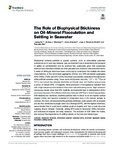The Role of Biophysical Stickiness on Oil-Mineral Flocculation and Settling in Seawater
| dc.contributor.author | Ye, L | |
| dc.contributor.author | Manning, Andrew | |
| dc.contributor.author | Holyoke, J | |
| dc.contributor.author | Penaloza-Giraldo, JA | |
| dc.contributor.author | Hsu, T-J | |
| dc.date.accessioned | 2021-11-15T12:47:30Z | |
| dc.date.available | 2021-11-15T12:47:30Z | |
| dc.date.issued | 2021-03-09 | |
| dc.identifier.issn | 2296-7745 | |
| dc.identifier.issn | 2296-7745 | |
| dc.identifier.other | 628827 | |
| dc.identifier.uri | http://hdl.handle.net/10026.1/18361 | |
| dc.description.abstract |
<jats:p>Biophysical cohesive particles in aquatic systems, such as extracellular polymeric substances (EPS) and clay minerals, play an important role in determining the transport of spilled oil contamination and its eventual fate, particularly given that suspended sediment and microbial activities are often prevalent and diverse in natural environments. A series of stirring jar tests have been conducted to understand the multiple structures characteristics of the oil-mineral aggregates (OMAs) and EPS-oil-mineral aggregates (EPS-OMAs). OMAs and EPS-OMAs have been successfully generated in the laboratory within artificial seawater using: Texas crude oil (Dynamic viscosity: 7.27 × 10<jats:sup>–3</jats:sup> Pa⋅s at 20°C), two natural clay minerals (Bentonite and Kaolin clay), and Xanthan gum powder (a proxy of natural EPS). A magnetic stirrer produced a homogeneous turbulent flow with a high turbulence level similar to that under natural breaking waves. High-resolution microscopy results show that EPS, kaolinite, and bentonite lead to distinguished oil floc structures because of the different stickiness character of EPS and mineral clay particles. With relatively low stickiness, kaolinite particles tend to attach to an oil droplets surface (droplet OMAs) and become dominant in small-sized flocs in the mixture sample. In contrast, the more cohesive bentonite particles stickiness could adsorb with oil droplets and are thus dominated by larger sized flocs. Biological EPS, with the highest stickiness, demonstrated that it could bond multiple small oil droplets and form a web structure trapping oil and minerals. Generally, adding EPS leads to flake/solid OMAs formation, and individual oil droplets are rarely observed. The inclusion of ESP within the matrix, also reduced the dependence of settling velocity on floc size and mineral type.</jats:p> | |
| dc.format.extent | 628827- | |
| dc.language.iso | en | |
| dc.publisher | Frontiers Media | |
| dc.subject | biophysical stickiness | |
| dc.subject | extracellular polymeric substance (EPS) | |
| dc.subject | oil-mineral aggregates (OMAs) | |
| dc.subject | flocculation | |
| dc.subject | settling velocity | |
| dc.title | The Role of Biophysical Stickiness on Oil-Mineral Flocculation and Settling in Seawater | |
| dc.type | journal-article | |
| dc.type | Journal Article | |
| plymouth.author-url | https://www.webofscience.com/api/gateway?GWVersion=2&SrcApp=PARTNER_APP&SrcAuth=LinksAMR&KeyUT=WOS:000631425600001&DestLinkType=FullRecord&DestApp=ALL_WOS&UsrCustomerID=11bb513d99f797142bcfeffcc58ea008 | |
| plymouth.volume | 8 | |
| plymouth.publication-status | Published online | |
| plymouth.journal | Frontiers in Marine Science | |
| dc.identifier.doi | 10.3389/fmars.2021.628827 | |
| plymouth.organisational-group | /Plymouth | |
| plymouth.organisational-group | /Plymouth/Faculty of Science and Engineering | |
| plymouth.organisational-group | /Plymouth/Faculty of Science and Engineering/School of Biological and Marine Sciences | |
| plymouth.organisational-group | /Plymouth/REF 2021 Researchers by UoA | |
| plymouth.organisational-group | /Plymouth/REF 2021 Researchers by UoA/UoA07 Earth Systems and Environmental Sciences | |
| plymouth.organisational-group | /Plymouth/Research Groups | |
| plymouth.organisational-group | /Plymouth/Research Groups/Marine Institute | |
| plymouth.organisational-group | /Plymouth/Users by role | |
| plymouth.organisational-group | /Plymouth/Users by role/Academics | |
| dcterms.dateAccepted | 2021-02-17 | |
| dc.rights.embargodate | 2021-11-16 | |
| dc.identifier.eissn | 2296-7745 | |
| dc.rights.embargoperiod | Not known | |
| rioxxterms.funder | Directorate for Geosciences | |
| rioxxterms.identifier.project | Collaborative Research: Understanding the physics of flocculation processes and cohesive sediment transport in bottom boundary layers through multi-scale modeling | |
| rioxxterms.versionofrecord | 10.3389/fmars.2021.628827 | |
| rioxxterms.licenseref.uri | http://www.rioxx.net/licenses/all-rights-reserved | |
| rioxxterms.licenseref.startdate | 2021-03-09 | |
| rioxxterms.type | Journal Article/Review | |
| plymouth.funder | Collaborative Research: Understanding the physics of flocculation processes and cohesive sediment transport in bottom boundary layers through multi-scale modeling::Directorate for Geosciences |


